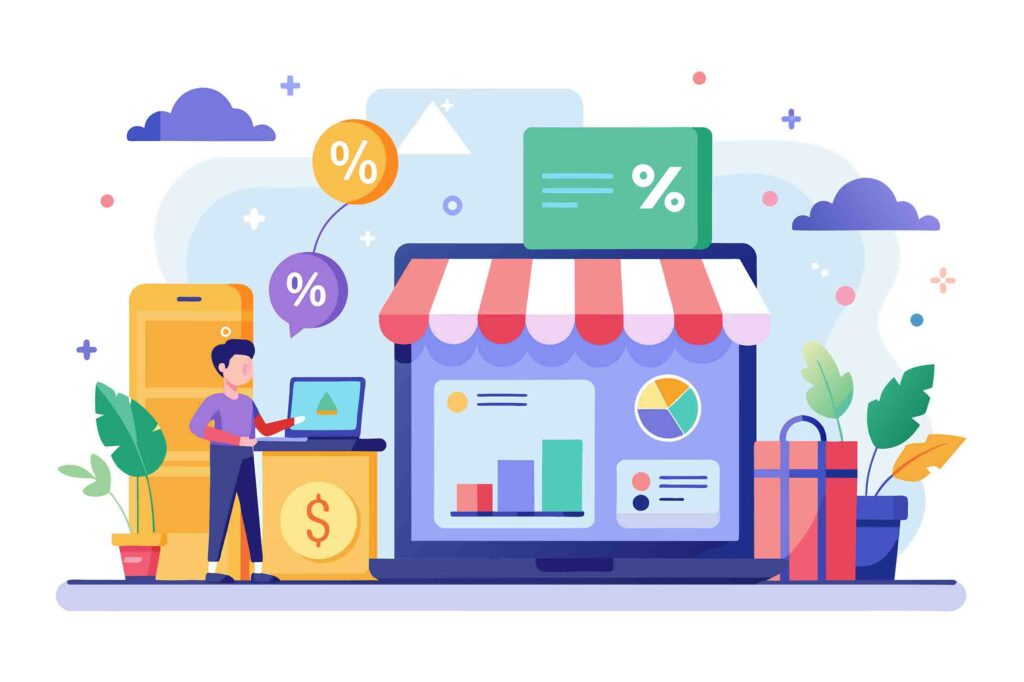
A Guide on How to Start an Ecommerce Business in 2024
How to start an ecommerce business is easier more than ever today. There are exceptional tools, techniques and proven ways to provide a good start to the business. Added to that the marketplace has also provided the right kind of environment for the growth.
However, as the growth chances have grown so are the challenges. Therefore, to get ahead of these challenges, it is critical to have the right action plan with you. Your Ecommerce business can come across a number of challenges and therefore identifying these potential challenges and finding the right solution becomes important.
To begin crafting your e-commerce business plan, first pinpoint the fundamentals—determine the products you’ll be offering and the most effective methods to market and sell them online. Outline your strategy for entering the e-commerce landscape. Next, highlight key elements that will drive your success. With a well-thought-out plan and the right tools, you can swiftly build your brand and launch a thriving e-commerce business. However, before we go further, let’s first understand a bit more about eCommerce.
What is Ecommerce business?
E-commerce involves the buying and selling of goods or services over the internet. This type of business can be conducted through various channels such as an e-commerce store, online marketplace, social media, or a mobile app. E-commerce allows businesses to provide a convenient shopping experience to a global audience, breaking down geographical barriers and enabling customers to purchase products anytime, anywhere.
Step-by-step Guide on How to Start an Ecommerce business
1. Select the Niche
To launch a successful online business, it’s crucial to identify the right niche. Start by evaluating your expertise and marketable skills. What unique knowledge do you possess, and how does it fit into the current market? Determine the type of products you wish to sell and understand your business vision.
Begin with thorough market research. Analyze competitors within your sector to understand their successes and shortcomings. When examining a thriving e-commerce business in your industry, consider these key questions:
- How are they reaching their customers?
- What aspects of their website are appealing?
- What is their business model?
Additionally, address some important logistical questions as you define your niche:
- Is your product physical or digital?
- If digital, how will you source it?
- Can you handle production on your own, or will you need assistance?
- Will your business focus on one-time orders, bundles, or a subscription model?
Generate as many business ideas as possible, keeping in mind that the e-commerce market is highly competitive. Reflect on what sets you and your business apart from others.
If you possess high-demand expertise, leverage it. For example, if you have extensive experience in freelance writing, you could start a blog to showcase your skills and establish yourself as an industry thought leader. Your e-commerce store could then offer services such as editing, print-on-demand, or paid online courses related to your expertise.
2. Do the Research
Identify the leading competitors in your industry and delve into their history and business models. Research trending products to spark ideas for your offerings. Consider what successful strategies they employ that you can adapt. Understand what customers in your niche are seeking and think about how you can meet these needs in a unique way.
Recognize the barriers to entry in your field and plan how to overcome them. Determine whether you’ll need to invest in advertising, e-commerce software, photography equipment, or design tools. If budget constraints are an issue, explore creative workarounds with the resources you have. Starting small and simple is perfectly acceptable when launching an e-commerce business.
Look for gaps in the market that your product or service can fill. Even if similar products exist, don’t be discouraged—aim to offer them in a distinctive way that sets you apart from the competition.
After establishing your market position and the value you bring to customers, consider conducting a SWOT analysis (Strengths, Weaknesses, Opportunities, and Threats). This analysis will help you identify potential challenges and plan strategically for the future of your e-commerce business.
3. Choose Target Audience, Find Target Market
When developing your product, leverage your personal experience. Have you worked in a particular industry that provides you with unique insights others might lack?
If you have a knack for spotting trends, use that ability to guide your decisions. Is there a gap in the market for a product that will soon be in demand based on industry trends? Identifying a relevant trend early can position you as a market leader.
It’s crucial to differentiate between trends and fads. A fad is a short-lived surge in popularity driven by novelty, which often fades quickly. Building your business around a fad may lead to a swift decline in demand once the initial hype subsides.
In contrast, a trend addresses an existing need in a novel way, offering more long-term viability. Trends tend to have greater staying power because they continuously meet a persistent demand. While fads can provide short-term e-commerce marketing opportunities, trends offer a more sustainable foundation for your business.
4. Validate Your Product
Now that you’ve conceptualized your product and identified your target audience, it’s essential to determine if you can realistically bring your idea to fruition. In other words, you need to assess the viability of your business.
To evaluate your product’s viability, you can use several criteria, which can be divided into two main categories: market-based and product-based criteria.
-
Market-Based Criteria:
Demand: Is there a significant demand for your product? Conduct surveys, analyze market reports, and look at search trends to gauge interest.
Competition: Who are your competitors, and what are they offering? Analyze their strengths and weaknesses to identify opportunities for differentiation.
Target Audience: Have you clearly defined your target audience? Understanding their preferences, behaviours, and purchasing power is crucial for success.
-
Product-Based Criteria:
Cost of Production: Can you produce your product at a cost that allows for a reasonable profit margin? Consider all expenses, including materials, labor, and overhead.
Quality and Durability: Is your product of high quality and durable enough to meet customer expectations? Testing and prototyping can help ensure it meets the necessary standards.
-
Scalability:
Can your business scale to meet increasing demand? Evaluate your supply chain, production capabilities, and logistics to ensure you can grow sustainably.
By thoroughly assessing both market-based and product-based criteria, you can determine if your business idea is viable and ready for execution.
5. Set Up Your Ecommerce Website
Get help from Ecommerce development company to set up your ecommerce website. Your e-commerce website is essentially your storefront, where customers will learn about your business, browse your products, and make purchases.
Setting up a website is easiest when using an online store builder. These platforms guide you through the entire process, from purchasing a domain name to managing inventory and processing credit card payments.
Popular e-commerce website builders include Shopify, Squarespace, Square Online, and BigCommerce.
For very small businesses or those just starting with online sales, a free e-commerce website builder might be a suitable option. However, to list unlimited products and access more advanced tools—such as shipping label printing, order management, and sales analytics—you’ll typically need to invest in a subscription plan.
Most online store builders are designed to be user-friendly, even for those without web development experience. Nonetheless, if you prefer not to build the website yourself, many platforms offer the option to hire a professional designer or developer.
Choosing the best e-commerce platform for your needs involves finding one that fits within your budget and aligns with your skill level.
6. Market Your eCommerce Business
Now that you’ve launched your online store, it’s time to start attracting customers to your products.
Your small-business marketing strategy could include
-
Omnichannel Commerce:
List your products on third-party marketplaces like Amazon and Instagram. Many e-commerce website builders can facilitate this process.
-
Influencer Marketing:
Partner with popular social media creators to promote your products to their followers.
-
Social Media:
Create engaging social media content or invest in paid social media advertisements.
-
SEO Optimization:
Optimize your website for search engines to improve visibility and drive organic traffic.
-
Email Campaigns:
Send targeted email campaigns to past and potential customers to keep them engaged and informed.
Many e-commerce website builders come with built-in marketing features to help you create social media ads or send automated emails to customers who have abandoned their carts.
For more advanced marketing efforts, consider investing in marketing software. These tools can help you design email templates and campaigns, send text messages to customers, and track individual customer responses to your marketing efforts.
By implementing a robust marketing strategy, you can ensure that your products are visible to your target audience, ultimately driving more traffic and sales to your online store.
How Much Does It Cost to start an eCommerce Business?
The cost of hiring eCommerce development company rather cost to start an eCommerce business can greatly vary.
This variation depends upon a number of factors explained below:
Your E-commerce Website: Subscription plans for online store builders typically start around $25 to $30 per month when billed annually. Additionally, you may need to purchase a domain name if it’s not included, and remember to budget for annual fees to keep your URL registered.
-
Payment Processing Fees:
The payment processing company will generally take a cut of around 3% from each online sale.
-
Stocking Up:
If you plan to order inventory in bulk, be prepared for significant upfront costs before generating revenue. Inventory financing can help bridge this gap.
-
Order Fulfilment:
You’ll usually pay a third-party service to fulfil each order, with rates varying based on item size and weight. Bulk orders can reduce per-item costs. Some order fulfilment services also offer warehousing, for which you’ll pay a per-item storage cost.
-
Warehousing:
If your inventory exceeds what you can store at home and you’re not using a fulfilment service with storage, you may need to rent warehouse space.
-
General Costs of Running a Business:
These can include fees for accounting software, business insurance, employee or contractor wages, and more. Don’t forget to set aside money for small-business taxes.
In Conclusion
Starting Your eCommerce business requires proper planning. The steps that have been listed above will help to create a business that will get you better ROI. Following the steps while taking help from a reliable eCommerce development company will help in the growth phase.
